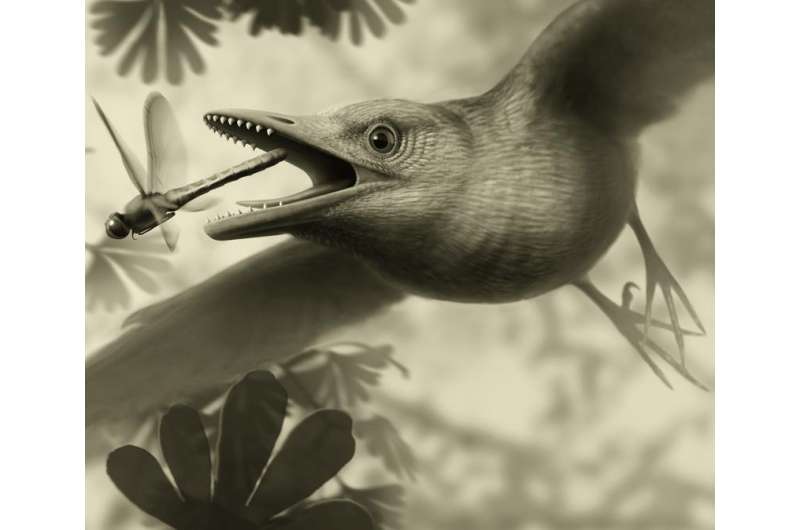Tiny ancient fossil from Spain shows birds flew over the heads of dinosaurs

Birds have an enormously long evolutionary history: The earliest of them, the famed Archaeopteryx, lived 150 million years ago in what is today southern Germany. However, whether these early birds were capable of flying—and if so, how well—has remained shrouded in scientific controversy. A new discovery published in the journal Scientific Reports documents the intricate arrangement of the muscles and ligaments that controlled the main feathers of the wing of an ancient bird, supporting the notion that at least some of the most ancient birds performed aerodynamic feats in a fashion similar to those of many living birds.
An international team of Spanish paleontologists and NHM's Director of the Dinosaur Institute, Dr. Luis M. Chiappe, studied the exceptionally preserved wing of a 125-million-year-old bird from central Spain. Beyond the bones preserved in the fossil, the tiny wing of this ancient bird reveals details of a complex network of muscles that in modern birds controls the fine adjustments of the wing's main feathers, allowing birds to master the sky.
"The anatomical match between the muscle network preserved in the fossil and those that characterize the wings of living birds strongly indicates that some of the earliest birds were capable of aerodynamic prowess like many present-day birds," said Chiappe, the investigation's senior scientist.
"It is very surprising that despite being skeletally quite different from their modern counterparts, these primitive birds show striking similarities in their soft anatomy," said Guillermo Navalón, a doctorate candidate at the University of Bristol in the United Kingdom and lead author of the report.
Ancient birds may have flown over the heads of dinosaurs but some aspects of the precise flight modes of these early fliers still remain unclear. "The new fossil provides us with a unique glimpse into the anatomy of the wing of the birds that lived amongst some of the largest dinosaurs," said Chiappe. "Fossils such as this are allowing scientists to dissect the most intricate aspects of the early evolution of the flight of birds." Other members of the research team included Dr. Jesús Marugán-Lobón, Dr. José Luis Sanz, and Dr. Ángela D. Buscalioni from Madrid's Universidad Autónoma in Spain.
More information: 'Soft-tissue and dermal arrangement in the wing of an Early Cretaceous bird: Implications for the evolution of avian flight' by Guillermo Navalón, Jesús Marugán-Lobón, Luis M. Chiappe, José Luis Sanz & Ángela D. Buscalioni in Scientific Reports www.nature.com/articles/srep14864
Journal information: Scientific Reports
Provided by Natural History Museum of Los Angeles County




















